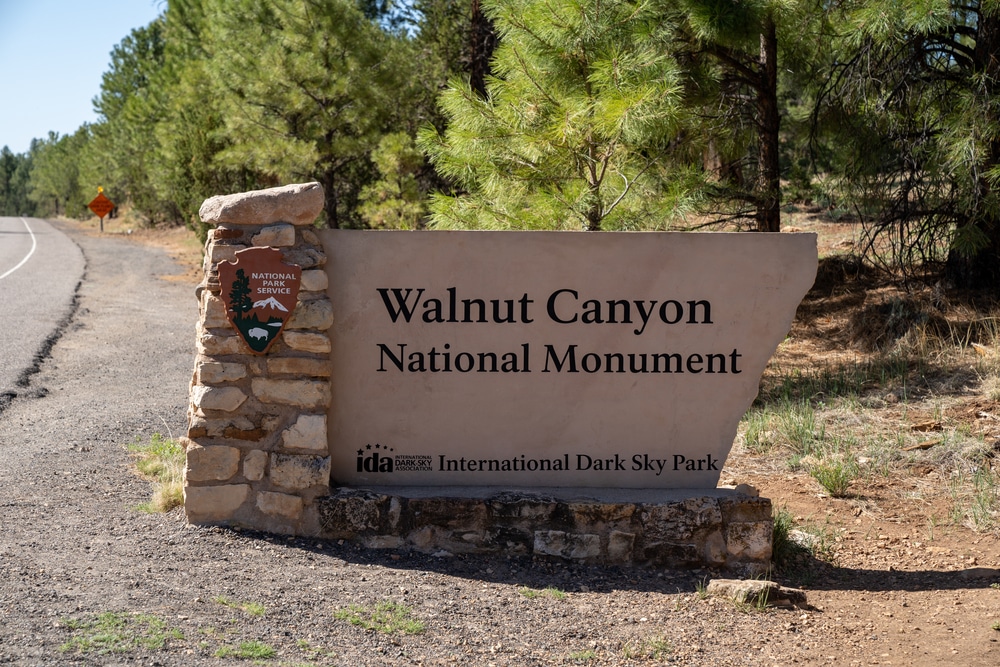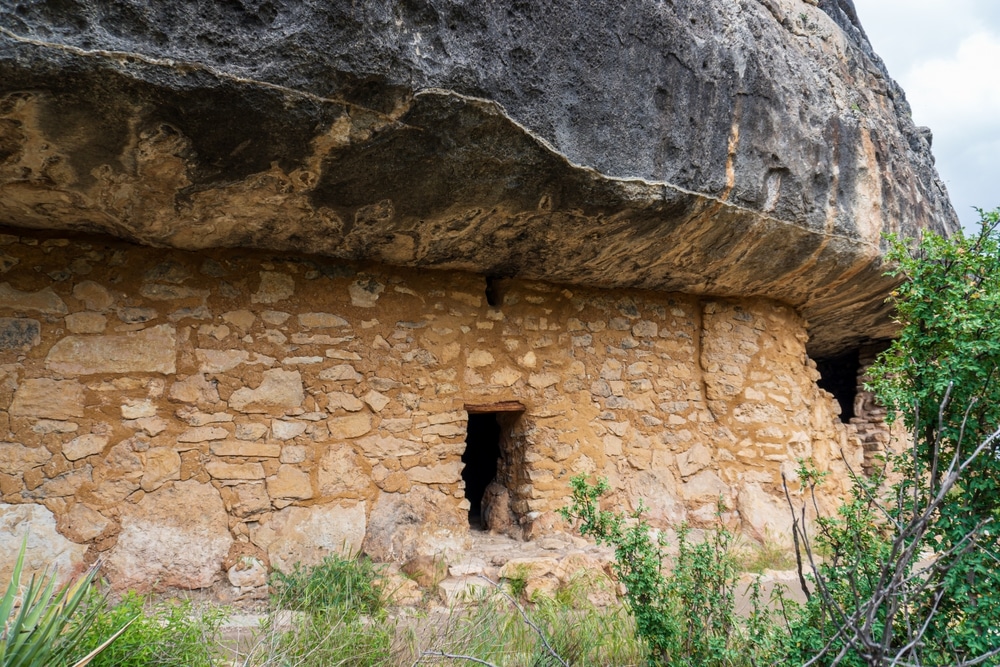- Privacy
- Terms
- Stay Connected
Nestled in the high desert landscape just east of Flagstaff, Arizona, Walnut Canyon National Monument preserves a remarkable collection of ancient cliff dwellings built ingeniously into the natural recesses of a dramatic limestone canyon. This 3,600-acre protected area stands as a testament to the resourcefulness and resilience of the Sinagua people, who made their homes in these seemingly inhospitable canyon walls nearly a millennium ago.
The monument takes its name from the black walnut trees that grow along the canyon floor, their deep green foliage creating a striking contrast against the buff-colored limestone cliffs that rise 400 feet from the canyon bottom. Carved over millions of years by the now-intermittent Walnut Creek, the canyon features distinctive horizontal bands of limestone and sandstone, with natural alcoves that the ancient inhabitants transformed into sheltered living spaces.
Established as a national monument in 1915 by President Woodrow Wilson, Walnut Canyon’s protection came after decades of looting and vandalism threatened these irreplaceable archaeological treasures. Today, the monument not only preserves approximately 300 cliff dwelling rooms but also protects a diverse ecological transition zone where the Colorado Plateau meets the mountainous highlands, creating a unique intersection of biological communities and breathtaking scenery.
Located just 10 miles southeast of Flagstaff, Walnut Canyon offers visitors an accessible yet profound encounter with Arizona’s ancient human history and natural beauty. The monument’s relative proximity to other significant public lands, including Sunset Crater Volcano and Wupatki National Monuments, makes it an essential component of any exploration of northern Arizona’s rich cultural landscape.

For an easier option, the Rim Trail offers a 0.7-mile walk along the canyon’s edge. This trail provides incredible views of the canyon below and passes by a reconstructed pit house and a small pueblo. It’s a great way to experience the monument’s beauty without the steep descent of the Island Trail.
The ancient Sinagua cliff dwellings, dating back to around 1100–1250 AD, are the main attraction of Walnut Canyon. These dwellings were built into natural alcoves in the canyon walls, offering protection from the elements. Visitors can see how the Sinagua people utilized the landscape to create homes and sustain their communities..
Throughout the monument, interpretive signs provide insights into the lives of the Sinagua people, who lived in the canyon over 800 years ago. Learn about their farming practices, use of natural resources, and the challenges of living in such a rugged environment.

The Island Trail is the highlight of the monument, taking visitors on a 1-mile loop through the heart of the canyon. This moderately strenuous hike includes 185 steps down into the canyon and provides access to ancient Sinagua cliff dwellings. Along the way, you’ll see preserved rooms built into the canyon walls and learn about the daily lives of the Sinagua people.

Begin your visit at the Walnut Canyon Visitor Center to gather information about the monument’s history, geology, and cultural significance. The center features exhibits on the Sinagua people, their lifestyle, and the flora and fauna of the canyon. Don’t miss the short video presentation, which provides an overview of the monument.

The canyon’s striking rock formations and lush vegetation create breathtaking views from the rim. Designated viewpoints near the Visitor Center offer panoramic perspectives of the canyon, perfect for photography or quiet contemplation.

Check the schedule for ranger-led activities, such as guided hikes and educational talks. These programs dive deeper into the history of the canyon, the Sinagua culture, and the area’s unique geology and ecology.

Walnut Canyon is home to diverse wildlife, including mule deer, squirrels, and a variety of birds. Keep an eye out for peregrine falcons soaring above the canyon or lizards basking on sunlit rocks.

The canyon is a transition zone between desert and mountain environments, resulting in varied plant life. You’ll see ponderosa pines, piñon trees, junipers, and desert wildflowers, depending on the season.

| Category | Details |
|---|---|
| Location | Near Flagstaff, Arizona, USA |
| Established | November 30, 1915 |
| Managed By | National Park Service |
| Size | Approximately 3,600 acres (1,457 hectares) |
| Main Attractions | Cliff dwellings, Island Trail, Rim Trail |
| Cultural Significance | Preserves over 300 Sinagua cliff dwellings from around 1100–1250 CE |
| Time Period | Dwellings date from approximately 1100–1250 CE |
| Geology | Limestone canyon carved by Walnut Creek on the Colorado Plateau |
| Ecosystem | Transitional zone between desert and ponderosa pine forest |
| Nearby Landmarks | Sunset Crater Volcano and Wupatki National Monuments (close proximity) |
| Visitor Activities | Hiking, wildlife viewing, ranger-led tours, photography |
| Climate | Warm summers, cold winters, with snow possible in winter |
| Entrance Fee | $25 per vehicle (valid for 7 days, subject to change) |
| Accessibility | Visitor center is wheelchair accessible; Island Trail is steep and strenuous |
| Fun Fact | The Sinagua people built their cliff dwellings to take advantage of natural shelter and shade within the canyon. |
The cliff dwellings of Walnut Canyon were built and inhabited by the Sinagua, a prehistoric cultural group that occupied the Flagstaff region from approximately 600 to 1400 CE. The name “Sinagua,” meaning “without water” in Spanish, was assigned by archaeologists to reference the people’s ability to thrive in an environment where water was often scarce and seasonal.
Archaeological evidence suggests that the Sinagua were initially pit house dwellers who practiced agriculture on the canyon rim. Around 1100 CE, they began constructing the cliff dwellings that are visible today, possibly in response to changing environmental or social conditions. The move to these defensible locations coincides with a period of increased population and social complexity throughout the region.
The Sinagua were skilled farmers who cultivated corn, beans, and squash on the canyon rim while taking advantage of the diverse plant and animal resources available within the canyon’s various ecological zones. They supplemented their agricultural production through hunting, gathering wild plants, and trading with neighboring indigenous groups, creating a sustainable lifeways finely adapted to this challenging environment.
Distinctive cultural elements associated with the Sinagua include their characteristic brown, orange, and red pottery traditions, cotton weaving, and architectural adaptations that blended indigenous building techniques with influences from neighboring Ancestral Puebloan groups. Trade items found at Sinagua sites, including shell ornaments from the Gulf of California and macaw feathers from Mexico, indicate their participation in extensive exchange networks that connected them to distant regions.
Walnut Canyon contains approximately 300 cliff dwelling rooms distributed along both sides of the canyon. These dwellings were constructed by building stone walls that enclosed natural recesses in the limestone, creating one to several room living spaces that provided shelter from the elements while requiring minimal construction materials.
The most distinctive architectural feature of these dwellings is their placement within a specific geological layer of the canyon walls. The Sinagua specifically chose to build within the Kaibab limestone formation, which naturally erodes to create alcoves ideal for habitation. A more resistant rock layer forms the “ceiling” of these spaces, while a softer layer below creates the “floor,” requiring only the addition of front and side walls to create a secure living space.
Notable architectural elements include:
Beyond the cliff dwellings themselves, archaeological features include agricultural terraces on the canyon rim, water control features that managed runoff, grinding stones (metates) for processing corn and other foods, and numerous examples of rock art that provide glimpses into the symbolic and possibly spiritual aspects of Sinagua culture.
The Sinagua appear to have abandoned their dwellings in Walnut Canyon by approximately 1250 CE, as part of a broader regional depopulation that affected much of the Colorado Plateau. The precise reasons for this migration remain a subject of scholarly debate, with potential factors including extended drought, resource depletion, social conflict, or a combination of environmental and cultural pressures.
While the physical occupation of Walnut Canyon ended, the cultural legacy of the Sinagua continues through their descendants among contemporary Native American tribes. Several modern indigenous groups, including the Hopi, Zuni, Havasupai, Yavapai, Hualapai, and others, maintain cultural connections to Walnut Canyon and similar sites through oral traditions, continued ceremonial practices, and ongoing consultation with the National Park Service regarding the management and interpretation of the monument.
For these tribes, Walnut Canyon represents not an abandoned ruin but an ancestral homeland with continuing spiritual importance. Their perspectives enrich our understanding of the site beyond purely archaeological interpretations, emphasizing cultural continuity rather than extinction and acknowledging the living traditions that connect past and present.
Walnut Canyon National Monument offers two primary hiking trails that allow visitors to experience the cliff dwellings and natural environment from different perspectives:
This moderately strenuous loop descends 185 feet from the rim into the canyon, following a path that circles a detached mesa-like formation nicknamed “the Island.” The trail passes directly through 25 cliff dwelling rooms, allowing visitors to enter these ancient spaces and gain an intimate understanding of how the Sinagua lived. With 240 steps each way, the Island Trail involves significant elevation change but rewards hikers with unparalleled access to the archaeological features and spectacular views of the canyon. Most visitors spend approximately 1 hour completing this loop, though those with particular interest in archaeology or photography may wish to allow additional time.
This relatively flat, partially paved trail follows the canyon’s edge, offering panoramic views of the canyon and distant cliff dwellings on the opposite wall. The trail includes a few partially reconstructed pit houses that illustrate the earlier dwelling style of the Sinagua before they moved into the cliff alcoves. Interpretive signs along the path explain the natural history of the canyon, the plant communities that supported Sinagua life, and the broader archaeological context of the site. This trail is wheelchair accessible and provides an excellent option for visitors unable to navigate the more strenuous Island Trail. Most visitors spend approximately 30-45 minutes on this trail.
Both trails feature interpretive signage that explains the archaeological and natural features visible along the route. For safety and resource protection, visitors must remain on designated trails at all times, as off-trail hiking is prohibited throughout the monument.
Walnut Canyon’s dramatic topography creates a remarkable diversity of microclimates and plant communities within a relatively small area. The canyon functions as a biological transition zone where species characteristic of several distinct ecological regions intermingle, creating exceptional opportunities for wildlife viewing and plant identification.
The canyon rim supports a piñon-juniper woodland typical of the Colorado Plateau, while north-facing slopes within the canyon host a mixed conifer forest more characteristic of higher elevations. South-facing slopes feature drought-adapted plant communities, and the canyon bottom supports riparian species associated with seasonal water availability.
This diversity creates habitat for numerous wildlife species, including:
Visitors interested in nature observation should bring binoculars and consider timing their visit for early morning when wildlife is most active. Spring (April-June) offers the additional attraction of blooming wildflowers, while autumn brings colorful foliage changes to the deciduous trees along the canyon bottom.
Walnut Canyon provides exceptional photographic opportunities for both landscape and archaeological photography. The combination of dramatic geology, ancient architecture, and changing light conditions throughout the day creates countless compelling compositions.
Notable photography subjects include:
The best lighting conditions typically occur during early morning and late afternoon when low-angle sunlight emphasizes the texture of the canyon walls and dwelling features. Winter visits offer the possibility of snow-dusted cliff dwellings, creating a striking contrast against the red-hued canyon walls.
The monument offers various ranger-led programs throughout the year, with increased frequency during the peak visitor season (late spring through early fall). These may include:
These programs are generally included with regular admission and provide an enhanced understanding of the monument’s cultural and natural resources. Visitors should check with the visitor center upon arrival for the current program schedule or consult the monument’s website for advance planning.
Walnut Canyon National Monument is located approximately 7.5 miles east of downtown Flagstaff, Arizona, via Interstate 40. Visitors should take exit 204 (Walnut Canyon Road) and follow the signs approximately 3 miles south to the monument entrance.
The monument is often visited in conjunction with nearby Sunset Crater Volcano and Wupatki National Monuments, which together showcase different aspects of northern Arizona’s natural and cultural history. All three can be visited in a single day, though those with particular interest in archaeology may wish to allocate additional time.
Walnut Canyon National Monument is typically open daily from 9:00 AM to 5:00 PM, with extended summer hours (8:00 AM to 5:00 PM) from Memorial Day through Labor Day. The monument is closed on Christmas Day.
While accessible year-round, each season offers distinctive experiences:
Moderate temperatures and blooming wildflowers make this an ideal time to visit. Canyon views are often exceptionally clear, and wildlife becomes more active after winter.
This is the busiest visitor season, with warmer temperatures moderated by the monument’s relatively high elevation (approximately 7,000 feet). Afternoon thunderstorms are common during the monsoon season (typically July-August), creating dramatic lighting but occasional trail closures during lightning activity.
Cooling temperatures and changing foliage create attractive conditions for hiking and photography. Visitor numbers decrease after Labor Day, offering a more tranquil experience.
The monument receives occasional snowfall, which transforms the landscape and creates unique photographic opportunities. Some sections of trails may be temporarily closed after snowfall for safety reasons, and visitors should be prepared for cold temperatures, particularly in shaded areas of the canyon.
An entrance fee is charged for visitors to Walnut Canyon National Monument. The fee is per person (children under 16 are free) and valid for seven days from purchase.
Various passes provide alternative entry options:
Walnut Canyon National Monument provides the following visitor facilities:
No food service or lodging is available within the monument boundaries, but both can be found in nearby Flagstaff, just 10 miles away. Visitors planning to hike the trails should bring water, particularly during warmer months, as no water is available once you leave the visitor center area.
The National Park Service has made efforts to accommodate visitors with diverse abilities:
Walnut Canyon is part of a constellation of national monuments in the Flagstaff area that together tell a comprehensive story of northern Arizona’s natural and cultural history:
Preserves a cinder cone volcano that erupted around 1085 CE, dramatically altering the landscape and affecting the indigenous populations who had been farming the area. The eruption’s timing coincides with significant changes in settlement patterns throughout the region, including the development of cliff dwellings at Walnut Canyon.
Protects several large pueblo structures built by the Sinagua and other indigenous groups following the eruption of Sunset Crater. These elaborate multi-story structures represent a different architectural adaptation to the northern Arizona environment than the cliff dwellings at Walnut Canyon.
Visiting all three monuments provides a more complete understanding of the environmental challenges and cultural adaptations that characterized human habitation in this region approximately 900 years ago.
Surrounding Walnut Canyon National Monument, Coconino National Forest encompasses almost 1.9 million acres of diverse landscapes ranging from red rock formations to ponderosa pine forests and alpine tundra. The forest offers extensive recreational opportunities including hiking, mountain biking, camping, fishing, and winter sports. Popular destinations within easy reach of Walnut Canyon include:
Elden Pueblo Archaeological Site: An interpretive trail through a significant Sinagua village site that provides additional context for understanding the culture responsible for Walnut Canyon’s cliff dwellings.
Sandy’s Canyon Trail: A scenic hiking route that connects to the Arizona Trail and offers views of similar geological formations to those found in Walnut Canyon.
Lake Mary Recreation Area: Offers fishing, boating, and camping opportunities in a forested setting.
Located approximately 80 miles northwest of Walnut Canyon, Grand Canyon National Park preserves one of the world’s premier natural wonders and showcases similar geological formations to those visible in Walnut Canyon, but on a vastly larger scale. The limestone layers that form the alcoves used by Walnut Canyon’s cliff dwellers are also prominent features in the upper walls of the Grand Canyon, providing a geological connection between these two significant protected areas.
To the northeast of Walnut Canyon lie the Navajo Nation and Hopi Reservation, sovereign tribal lands that offer opportunities to experience living Native American cultures with connections to the ancient peoples of Walnut Canyon. Visitors interested in understanding the cultural continuity between past and present can explore tribal museums, cultural centers, and guided experiences that illuminate these connections.
Walnut Canyon National Monument faces several ongoing preservation challenges:
Despite legal protections, looting and vandalism remain concerns for the exposed archaeological resources. The monument employs various protective strategies including ranger patrols, electronic monitoring, and public education about the irreplaceable nature of these cultural treasures.
The cliff dwellings, exposed to natural weathering processes for nearly 800 years since their abandonment, require periodic assessment and stabilization work to ensure their long-term preservation and visitor safety.
The forested landscape surrounding the canyon presents complex fire management challenges. While fire is a natural component of the ecosystem, uncontrolled wildfire could threaten both the monument’s cultural resources and visitor facilities. The monument works with neighboring land management agencies to implement appropriate fire management strategies, including prescribed burns and thinning projects.
Non-native plants and animals can disrupt the natural ecological balance and potentially impact archaeological resources. Ongoing monitoring and management efforts focus on preventing the establishment and spread of invasive species within the monument boundaries.
Changing precipitation patterns, increased temperature extremes, and other climate-related changes pose long-term challenges for both natural and cultural resources at Walnut Canyon. The monument is implementing climate change adaptation strategies to monitor and mitigate these impacts where possible.
Scientific research continues at Walnut Canyon, though using less invasive methods than the extensive excavations of the early 20th century. Current research priorities include:
This research not only contributes to scholarly understanding of Sinagua culture but also informs conservation strategies and enhances interpretive programs for visitors.
The National Park Service maintains government-to-government relationships with numerous federally recognized tribes who claim cultural affiliation with Walnut Canyon, including the Hopi Tribe, Navajo Nation, Zuni Pueblo, and others. These partnerships involve:
These relationships acknowledge that Walnut Canyon represents not just an archaeological resource but a living cultural heritage that maintains significance for contemporary indigenous communities.
Walnut Canyon’s natural environment requires visitors to take certain precautions for their safety:
At approximately 7,000 feet elevation, visitors from lower elevations may experience shortness of breath or fatigue more quickly than expected. The Island Trail’s 240 steps each way represent a moderately strenuous activity that requires adequate physical conditioning. Visitors should pace themselves, rest as needed, and consider their personal fitness level when choosing which trails to hike.
Weather conditions can change rapidly in northern Arizona. Summer visitors should be prepared for intense sun exposure, while winter visitors may encounter snow and ice on trails. During monsoon season (July-August), afternoon thunderstorms can develop quickly, creating lightning hazards in exposed areas.
The dry climate and relatively high elevation increase water loss through respiration and perspiration, even in cooler weather. Visitors should carry and drink sufficient water, particularly when hiking the Island Trail.
Trails involve uneven surfaces, steps, and occasionally slippery conditions. Sturdy footwear with good traction is strongly recommended.
Portions of both trails have significant drop-offs along the canyon rim. Visitors should maintain safe distances from edges, especially when accompanying children or during windy conditions.
While dangerous wildlife encounters are rare, visitors should maintain appropriate distances from any animals encountered. During warmer months, awareness of potential rattlesnake habitat is advisable.
To ensure the protection of Walnut Canyon’s irreplaceable cultural and natural resources, visitors are asked to follow these guidelines:
As a site with ongoing significance to multiple Native American tribes, Walnut Canyon deserves particular respect for its cultural dimensions:
Photography for personal use is encouraged throughout the monument, with these considerations:
Walnut Canyon National Monument offers visitors a remarkable opportunity to connect with both the natural landscape of northern Arizona and the ingenious human adaptations that allowed ancient peoples to thrive in this challenging environment. The cliff dwellings, tucked into the natural recesses of this limestone canyon, stand as powerful reminders of the Sinagua people’s resourcefulness and their intimate knowledge of local ecology.
Beyond its archaeological significance, Walnut Canyon showcases the dynamic interaction between geology, climate, ecosystems, and human culture. The same features that made the canyon attractive to its ancient inhabitants—reliable water sources, diverse plant communities, defensible locations, and natural shelter—continue to create a compelling destination for modern visitors seeking to understand Arizona’s deep human history.
As part of the larger constellation of protected public lands in northern Arizona, Walnut Canyon contributes to our comprehensive understanding of how diverse indigenous cultures responded to environmental challenges and opportunities across this varied landscape. When experienced in conjunction with nearby Sunset Crater Volcano and Wupatki National Monuments, visitors gain insights into the complex interplay between natural events and cultural developments that shaped human history in this region around 900 years ago.
For today’s visitors, Walnut Canyon offers not just an educational experience but also moments of connection—connection to the ingenuity of ancient builders who transformed natural alcoves into comfortable homes; connection to the descendant communities who maintain cultural ties to this ancestral place; and connection to the ongoing efforts to preserve this fragile yet resilient landscape for future generations.
Through respectful visitation and support for conservation efforts, we can help ensure that the cliff dwellings of Walnut Canyon continue to tell their story of human adaptation and environmental relationship for centuries to come—a story that remains relevant as we face our own challenges of sustainable living in the diverse landscapes of the American Southwest.